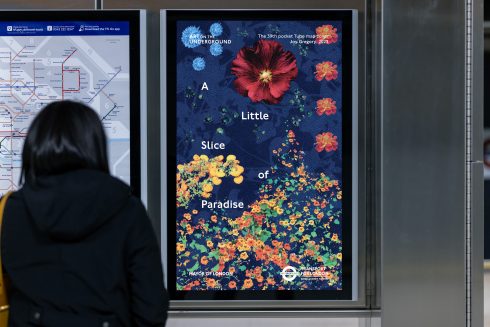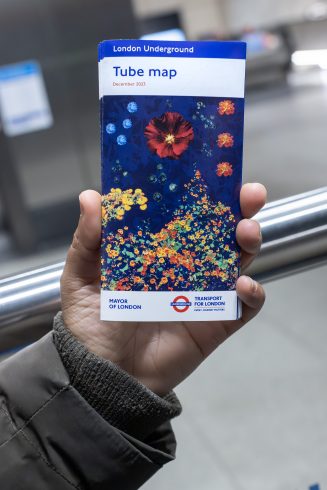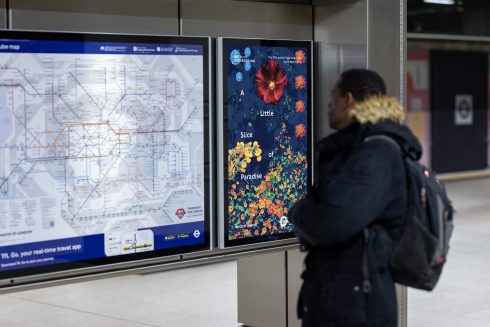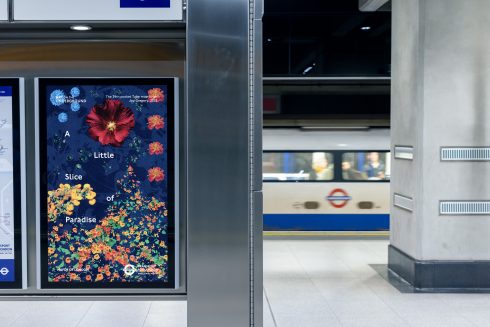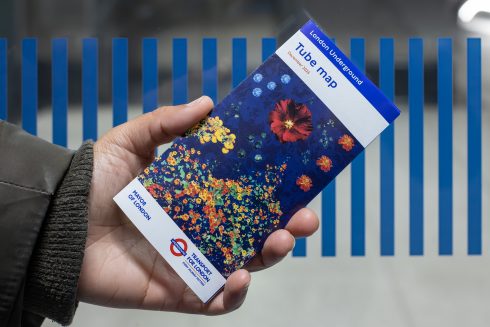Art on the Underground presents a new artwork for the 39th pocket Tube map cover by leading British artist Joy Gregory.
Titled A Little Slice of Paradise and inspired by Transport for London’s 100-year history of staff cultivated station gardens, Joy Gregory has created a rich photographic collage for the cover of the December pocket Tube map.
Renowned for her influence on British feminist photography and social justice movements, Gregory uses photographic media to re-illuminate forgotten cultural, historical and political narratives. As a British artist of Jamaican heritage Gregory’s practice often explores on the relationship between colonialism and identity and plant knowledge.
Since 1910, Transport for London has run an annual competition called ‘In Bloom’, which recognises staff for their efforts cultivating gardens in unlikely station environments.
Inspired by TfL’s gardens, Gregory wanted to create a Tube map cover for the people who will experience the artwork most frequently – station staff. A Little Slice of Paradise pays tribute to staff and their gardens.
The title was inspired by a conversation Gregory had with gardener and Customer Service Manager, Tony Samuel, who described the garden he and his colleagues had created at Morden station as ‘a little slice of paradise’.
The artwork features a cyanotype imprint of chickweed grown in station gardens digitally collaged with photographs of flowers including camellias, dahlias, daisies, and nastursiums in station gardens. Gregory often uses camera-less photographic techniques such as cyanotypes, which captures the imprint of an object laid on top of light sensitive photographic paper in blue hues. The cyanotype was notably used by some of the earliest known women photographers to document botanical objects at a time when women were discouraged from engaging with the sciences. In her practice, Gregory draws on this feminist history using the cyanotype to re-illuminate and reframe overlooked narratives about identity, race, gender and social history which underscore contemporary society.
Evocative of the rich palette of Dutch Old Master flower paintings and the histories of photography, Gregory’s artwork offers customers a reminder of the station gardens to carry with them as they travel through the city.
Art on the Underground will unveil a new large-scale work by Joy Gregory at Heathrow terminal 4 station in June 2024, an extension of her Tube map artwork.
Joy Gregory, Artist said: “The most beautiful and rewarding part of working on this commission was seeing the positive impact these gardens had on the lives of people using the transportation system, as well as the pleasure it conveyed to the creators of these enchanting spaces and their colleagues.”
Justine Simons OBE, Deputy Mayor for Culture and Creative Industries, said: “Our Tube stations are not just transport hubs, they are icons of design and each one has something that makes it special. Cultivated gardens on London’s transport network are part of that rich tapestry and I want to thank artist Joy Gregory for merging past and present floral designs in the new pocket Tube map cover.
“It is a wonderful daily reminder for all of us who travel on the Tube network of the effort and dedication TfL staff have put into maintaining these magnificent gardens. Thank you for making our commute more enjoyable, helping us build a greener and better London for all.”
Eleanor Pinfield, TfL’s Head of Art on the Underground, said: “Gregory has turned a spotlight on a fascinating part of TfL’s history and a vibrant part of its contemporary life. Bringing the botanical to the front of the pocket Tube map is a fitting tribute to TfL staff who nurture plants year-round. This new artwork is a poignant reminder of the care that staff bring to the spaces we use every day as we travel.”
About Joy Gregory
Joy Gregory is an important and influential artist sometimes overlooked by the mainstream as her work does not easily fit into any framework. Her practice is concerned with social and political issues often making particular reference to histories and cultural differences, which characterise contemporary society. The work is highly intelligent, thoughtful and challenging, tending toward a seductive aesthetic which underlines its relevance and accessibility across class, race, cultural, and economic divides. As an artist, she makes full use of the media from video, digital and analogue photography to Victorian print processes. She studied at Manchester Polytechnic (1984) and the Royal College of Art (1986) where she graduated with an MA in Photography. She has exhibited all over the world and shown in many biennales and festivals and is also the recipient of numerous awards.
Her work included in many collections including the UK Arts Council Collection, Victoria and Albert Museum, Institute of Modern Art, Brisbane, Australia, and Yale British Art Collection. She currently lives and works in London. In 2002, Gregory received the NESTA Fellowship and is currently a Visiting Scholar at Yale Centre of British Art in New Haven researching for new work. She has recently completed a commission for the Royal Albert Memorial Museum and NPG Artist Residency at The Exchange, Newlyn in Penzance.
In 2023, she won the Freelands Foundation Award for the first major retrospective of her work at the Whitechapel Gallery in autumn 2025. As well as being a highly respected artist, Gregory is a renowned educator of 30 years with a wide range of experience from formal to community and elementary schools to higher education. She has been the Director of Higher Education programmes in the UK and overseas and was the external examiner for the MFA in Photography at the National Institute of Design, India and the BA Fine at Duncan & Jordanstown. Joy has also been involved in a variety of photography mentorship programmes including a project around climate change for the British Council in Nigeria and for the Market Photography Workshop in Johannesburg training marginalized communities in the Kalahari to take control and tell their own stories without being filtered by an outside voice.
